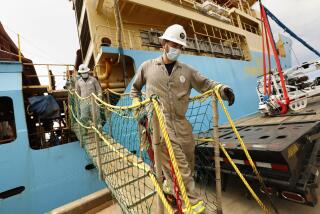Scientists Drill Beneath Ocean Floor for Mud to Study Planet’s Evolution
- Share via
Drilling thousands of feet into the ocean’s floor, an international team of scientists is reaching back tens of millions of years to learn more about the planet’s evolution.
The medium is the mud.
Aboard this converted oil-drilling vessel stationed at the edge of the continental shelf, researchers are pulling samples of mud from as deep as 4,300 feet below the ocean floor to record the rise and fall of sea level over the past 50 million years.
Breaks in the mud, which signify a change in sea level, also reveal past episodes of global warming when giant ice sheets melted, causing oceans to rise, the researchers say.
“The Jersey shore is a natural laboratory of the Earth’s own rhythms,” said Gregory Mountain, a Columbia University geologist who directs the project with Ken Miller of Rutgers University.
“If the sediments can tell us how sea levels have changed naturally over the millennia, we’ll be better able to understand future changes, both natural and man-made,” Mountain said. “We’ll be able to deal more intelligently with the complex range of effects that global warming may have on shorelines around the world.”
While the international team drills offshore, the United States Geological Survey is drilling at three New Jersey coastal sites--Island Beach State Park, Atlantic City and Cape May--to get a larger picture of “what happened on the New Jersey coastal plain since the dinosaurs died,” Rutgers geologist Jim Browning said.
On a recent day at a drilling site about 90 miles east of Atlantic City, scientists were withdrawing samples of sediment from 2,100 feet--and 35 million years--below the bottom of the sea. The ocean floor there is at a depth of 1,452 feet.
The project’s 25 scientists and 85 support personnel work around the clock to examine nearly all the grayish muck recovered during the 40 days of drilling time allotted them.
The high-tech JOIDES Resolution has been sailing the world’s seas since 1985 as part of the Ocean Drilling Program run by Texas A&M; University. JOIDES stands for Joint Oceanographic Institute for Deep Earth Sampling, an advisory board of scientists from 19 member countries.
Sixty percent of the program’s $42 million yearly cost is paid by U.S. taxpayers through the National Science Foundation. Other countries involved in the projects contribute the other 40%.
The $150 million vessel--470 feet long and 70 feet wide with a derrick 216 feet above the waterline--has logged 169,415 nautical miles during that time, said Capt. Ed Oonk of Enschede, the Netherlands.
It also has recovered more than 232,545 feet of sediment and rocks from 903 drilled holes, according to drilling operations supervisor Glenn Foss.
A computer-controlled “dynamic positioning system” uses 12 thrusters to keep the ship nearly stationary without anchoring as drilling tubes bore deep into the earth.
“Few ships in the world have this,” Ray Frank, who operates the system, said.






